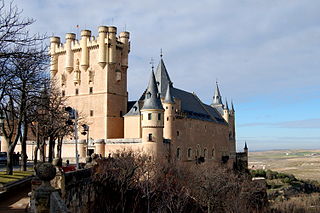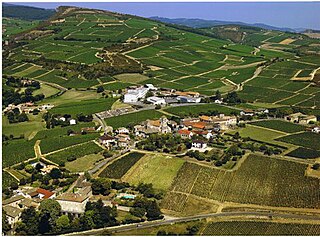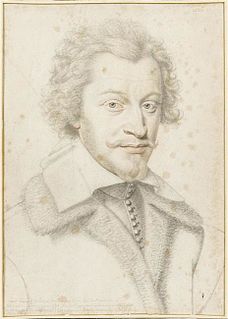
Hugh X de Lusignan, Hugh V of La Marche or Hugh I of Angoulême succeeded his father Hugh IX as Seigneur de Lusignan and Count of La Marche in November 1219 and was Count of Angoulême by marriage.

Bâgé-le-Châtel is a commune in the Ain department in eastern France.

Paul Abadie was a French architect and building restorer. He is considered a central representative of French historicism. He was the son of architect Paul Abadie Sr..
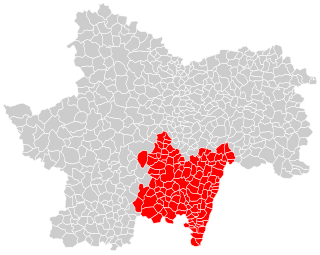
The arrondissement of Mâcon is an arrondissement in the department of Saône-et-Loire, in the French region of Bourgogne-Franche-Comté. Since the January 2017 reorganization of the arrondissements of Saône-et-Loire, it has 122 communes.

Charles of Orléans was the Count of Angoulême from 1467 until his death. He succeeded his father, John, and was initially under the regency of his mother, Marguerite de Rohan, assisted by Jean I de La Rochefoucauld, one of his vassals.

The Château de Montbéliard, also known as the Château des ducs de Württemberg is a fortress located on an outcropping rock that overlooks the town of Montbéliard in the Doubs département of France. Since 1996, it has been classified as a monument historique by the French Ministry of Culture. The property of the commune, it is open to the public.

Anduze is a commune in the Gard department in southern France. The village is at the foot of the Cevennes range, in the limestone plateau of the Languedoc scrublands.
Yolanda of Lusignan or Yolande I & I de Lusignan, Countess of La Marche was a French noblewoman and peeress. In 1308, she succeeded her brother Guy I as suo jure Dame of Lusignan, of Couhé and of Peyrat, and suo jure Countess of La Marche, but not as Countess of Angoulême since after her brother's death the county was sold by her sisters, Joan and Isabelle, to King Philip IV and annexed to the French Crown. Yolanda was also the heiress of Fougères, which she succeeded to upon her mother's death sometime after 1273.

Alloue is a commune in the Charente department in the Nouvelle-Aquitaine region of southwestern France.
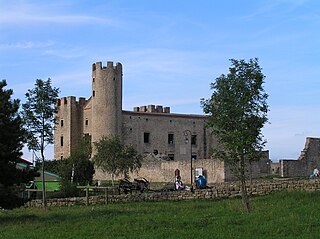
The Château d'Essalois is a restored castle in the commune of Chambles in the Loire département of France, overlooking a dammed portion of the Loire River, Lake Grangent.
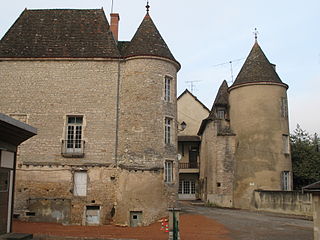
The Château de Lugny is a castle in the commune of Lugny in the Saône-et-Loire département of France.

The Château de Brandon is a castle in the commune of Saint-Pierre-de-Varennes in the Saône-et-Loire département of France.
Jeanne d'Angoulême, Countess of Bar-sur-Seine, Dame de Givry, Baroness of Pagny and of Mirebeau, was an illegitimate half-sister of King Francis I of France and princess Marguerite de Navarre. She was created suo jure Countess of Bar-sur-Seine in 1522. She was the wife of Jean de Longwy, Seigneur of Givry, Baron of Pagny and of Mirebeau.

Jeanne de Fougères, was ruling suo jure Lady of Fougères from 1256. She was the wife of Hugh XII of Lusignan, Count of La Marche and Count of Angoulême. Jeanne was responsible for the later additions and fortifications of the Chateau of Fougères which provided a greater stability for the town.

Le Château de Rambures is a castle situated in the commune of Rambures in the Somme département of France.
Alice of Courtenay, Countess of Angoulême was a French noblewoman of the House of Courtenay. Her father was Peter I of Courtenay and her brother was Peter II of Courtenay, Latin Emperor of Constantinople. Alice married twice; by her second husband, Aymer Taillefer, Count of Angoulême, she was the mother of Isabella of Angoulême, who was Queen consort of England, as the wife of King John.

The Château de Corcelle is a castle located in the commune of Bourgvilain in Saône-et-Loire département of France, on a small plateau dominating the valley of the Valouze.
The canton of Cluny is an administrative division of the Saône-et-Loire department, eastern France. Its borders were modified at the French canton reorganisation which came into effect in March 2015. Its seat is in Cluny.
